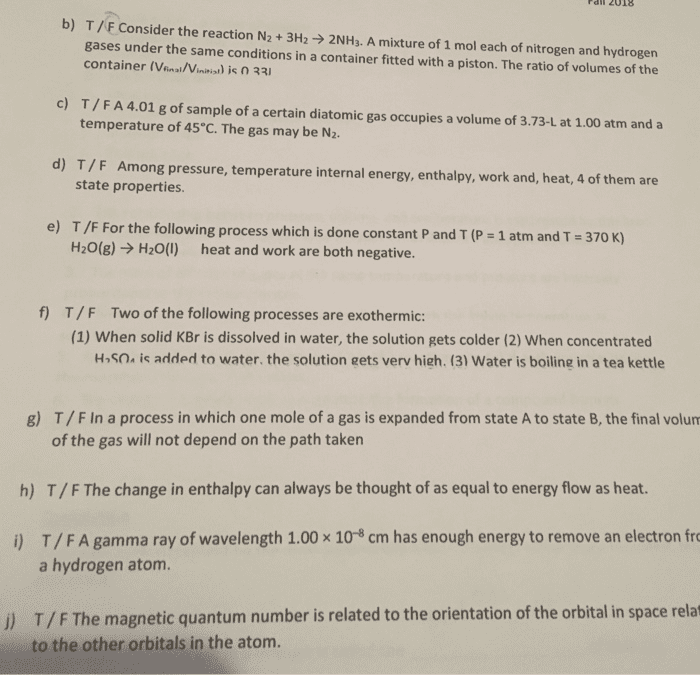Practice problems for exam 2 ______________
Useful Information:
h=6.626Ã10-34J·s.; c=3.0Ã108 m/sec; E=hï® ; E= hc , ï¬ = h/mv; 1J = 1 kg-m2/s2 ï¬
mass of electron = 9.11 Ã 10-28 g, ïE= q + w ; 1 cal = 4.184 Joules Please Show all Work
1. Which of the following substances have standard heats of formation that are equal to zero by definition (circle your answers): H2(g), H(g), O3(g), H2O(s), H2O(l), Hg(l), Hg(s), Hg(g).
2. Limestone stalactites are formed in the reaction: Ca2+(aq) + HCO3-(aq) ï CaCO3(s) + CO2(g) +
H2O(l)
If one mole of CaCO3 is produced at 298 K under one atmosphere of pressure, the reaction performs 590 calories of expansion work, pushing back the atmosphere as CO2 is formed. At the same time, 9310 calories of heat are absorbed from the environment. What is ïE in Kcal/mole for CaCO3.
3. What is the minimum wavelength of light in AÌ (1 AÌ = 10-8 cm) needed to provide enough energy per quantum to rupture the chemical bond in hydrogen iodide (HI). The bond dissociation energy of HI is 71.4 Kcal/mole.
1
4. Sketch the shape and orientation of the following types of orbitals: s, px, dxy, dz2, dx2-y2
5. Give the values of (n) , (l) and (ml) for each orbital in the 4p subshell.
6. Write the complete electron configuration for the following: Ti 2+_____________________________________ Cr_______________________________________
N______________________________________
7. Calculate the standard enthalpy of formation ( ï Ho) for diamond from graphite [i.e. C (graphite) ï C (diamond)] given that:
C (graphite) + O2 ï CO2 (g) ( ï Ho = -393.5 KJ/mole) C (diamond)] + O2 ï CO2 (g) ( ï Ho = -395.4 KJ/mole)
If 1.0g of graphite is converted to diamond, what is the energy change? Is this an endothermic or exothermic reaction?
2
8. An 160 pound astronaut on his way to Mars is buzzing along at 10,000 miles per hour. (a) Express his weight in grams (one pound = 454 grams) so that you can calculate the astronautâs wavelength (1mile/hour = 44.7 cm/sec)
(b) Suppose the astronaut detects outside his spacecraft a proton (m=1.7 x 10-24 g) from a âsolar windâ moving at exactly the spacecraft velocity. What is the proton wavelength is in AÌ (1 AÌ = 10-8 cm.
9. What is the maximum number of electrons that can occupy each of the following subshells? a) 3d_________________ b) 1s____________________ c) 2p ____________________
10. Identify the element represented by the following electronic configuration.
a) [Ne] 3s2____________________
b) What is the electron configuration for the first excited state of this atom.______________
11. Determine the number of valence electrons for each element.
(a) Br___________ (b) Na _________ (c) Sn __________
3
12. 175 g of Fe at 15.0oC is mixed with 225 g of H2O at 95.0oC. What is the final temperature of the mixture? The specific heats of iron= 0.448 J/g oC and water = 4.184 J/g oC). (keep in mind the following: heat gained + heat lost = 0 and q=mass x heat capacity x ïT)
13. (5 pts) Calculate values of ÎHrxn for the following reactions: CS2(g) + 3O2(g) ï® CO2(g) + 2SO2(g)
The heat of formation for the following substances is given in kJ/mol:
CS2 CO2 SO2 117.4 -393.51 -296.83
14. (6 pts) Use the electron configuration of Li and Be and determine which element has the greatest second ionization energy. Defend your answer.
4
15. Mark beside each of the following processes either âexoâ or âendoâ according to whether you think the process will release heat or absorb heat.
a. Ca(g) ï Ca(g)+2 + 2e-
b. I(g)+1e-ï I(g)-1
c. Ca(g)+2 + S(g)-2 ï CaS(s) d. I2(g)ï 2I(g)
( ) ( ) ( ) ( )
16. (6 pts) In each of the following pairs, which of the two species is larger?
a) O-2 or Na+ b) Ti+4 or Ti+2 c) B or C d) N or N-3
17. Write down the Lewis dot structure for the following (a) N_______________ (b) Ne________________
18. THE BORN HABER CYCLE: I may have a problem on the Born Haber cycle. Please check my lecture notes to see how to set up the process and then calculate the lattice energy from the various thermodynamic quantities such as in the NaCl example below;
ï H ï¯ f NaCl = -411KJ
Na(s) ï® Na(g) ï H =108KJ
1â2 Cl2 ï® Cl(g) ï H = 122KJ Ionization Energy of Na ï H = 496 KJ Electron affinity of Cl ï H = -349KJ



